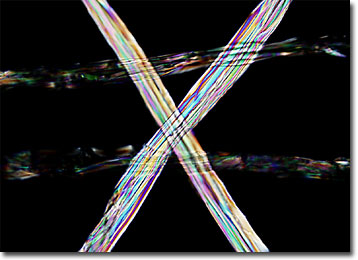Polarized Light Microscopy Digital Image Gallery
Thrown Raw Silk Fibers
The art of silk production was developed several thousand years ago in China, where the sericulture process was kept as a closely guarded secret for a long period of time. In fact, according to legend, silkworms were not found in Europe until at least the sixth century AD, when they were smuggled out of China by monks who hid them in hollow bamboo canes.

View a second image of Thrown Raw Silk Fibers
Today, the larvae of several moth species belonging to the genus Bombyx produce most commercial silk, although other creatures, such as spiders, can produce a similar animal fiber. Domesticated for an extensive period of time, these larvae, commonly known as silkworms, have lost the ability to survive in the wild, though presumably related species may still be found in nature. When ready for metamorphosis, each silkworm spins a cocoon that consists of a single long strand held together by a gummy substance called sericin. Usually the cocoons are steamed or heated in order to stem larval development and are then unwound, or reeled, via mechanical means. Subsequently, in order to produce thicker, more widely useable yarns, the reeled silk is often thrown, a process that involves the twisting together of several strands of the fiber.
Silk that retains its natural sericin is called raw silk. The gelatinous nitrogenous protein is frequently left in place during much of the processing of silk fiber because it provides a certain amount of protection to the delicate strands. However, the sericin is usually removed in the yarn or fabric stage by subjecting the material to boiling water and soap. The result is a very soft, lustrous, semitransparent silk that may be reduced in weight by as much as 30 percent. Beautiful, relatively strong, and highly accepting of dyes, this final material is a popular choice for fine garments and textiles that are in high demand around the world.
